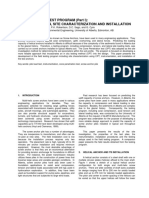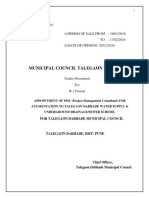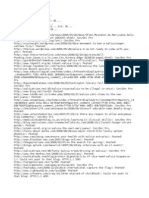Comparative Study and Analysis of The Lateral and Vertical Loads of Pile Foundation
Comparative Study and Analysis of The Lateral and Vertical Loads of Pile Foundation
Uploaded by
Rahul KolateCopyright:
Available Formats
Comparative Study and Analysis of The Lateral and Vertical Loads of Pile Foundation
Comparative Study and Analysis of The Lateral and Vertical Loads of Pile Foundation
Uploaded by
Rahul KolateOriginal Description:
Original Title
Copyright
Available Formats
Share this document
Did you find this document useful?
Is this content inappropriate?
Copyright:
Available Formats
Comparative Study and Analysis of The Lateral and Vertical Loads of Pile Foundation
Comparative Study and Analysis of The Lateral and Vertical Loads of Pile Foundation
Uploaded by
Rahul KolateCopyright:
Available Formats
International Journal of Engineering Trends and Technology (IJETT) Volume-45 Number4 -March 2017
Comparative Study and Analysis of the
Lateral and Vertical Loads Of Pile Foundation
Shashi Kumar1, Harika Priya2
1,2
Department of Civil Engineering
1,2
Lords Institute of Engineering and Technology, Himayathsagar, Hyderabad, India
Abstract Pile foundations are common foundations summarised the points that need to be amended to
for bridge abutment, piers and buildings resting on Indian codes of practice to meet the state of the art
soft soil strata. Piles are structural members that are developments in the subject. Presented in this
made of steel, concrete, or timber. They are used to research paper are the results of a competetive and
build pile foundations. Despite the cost, the use of Analysis of Laterally and Vertically Loaded of Pile
piles often is necessary to ensure structural safety. foundations. compressive clay soil comparasion in
piles are used in construction work, depending on cohesive soils, cohesiveless soils change parameters
the type of load to be carried, the subsoil conditions, of pile ( Length) depth in meter considered as
and the location of the water table The objective of primary parameter. Analysis is performed both for a
the current study is to carry out parametric analysis single pile and a pile group. It was observed that
of a group of piles by analyzing using finite element lateral and vertical loaded pile foundation analysis.
method & comparing the results obtained using
empirical equations(Brom s method and Vesics II. SOIL INVESTIGATION
method) . The piles are modelled as linear elements. The overall purposes of this study are to
The effect of soil structure interaction is taken into investigate the stereography at the site, perform a
account by assuming it as vertical and horizontal detailed liquefaction susceptibility analysis for the
soil spring (winkler soil spring) . Lateral subgrade site, and to develop geotechnical recommendations
modulus and vertical subgrade modulus of soil (KH for design and construction of foundations for the
and kv) is calculated as per is code 2911. The pile proposed building and associated facilities. Static
group is subjected to both vertical and horizontal cone penetration tests to get the additional data for
forces. foundation analysis.
Testing selected soil and groundwater
Keywords Spring Constants, Pile Foundation, sample in the laboratory to determine pertinent index
Static Analysis, Staad Pro. and engineering properties of the soils.
analyzing all field and laboratory data in
I. INTRODUCTION order to develop engineering recommendations for
Pile foundations are adopted commonly for foundation design and construction. This reports
various types of multi-storeyed structures when the presents our engineering analysis and
founding soil is weak and soft; and also in industrial recommendations for the entire plant site, including
structures, bridges, offshore structures. With detailed liquefaction susceptibility analysism
increasing infrastructural growth and seismic Cohesiveness, soil angle of friction, Density water
activities, designing the pile foundations for load levels SPT N Values Static Cone Penetration Test:
bearing conditions and soil conditions is of The static cone penetration is a specialized
considerable importance for the efficient function of penetration test to obtain a profile of soil resistance
the structures especially, the lifeline structures like with depth. The test was conducted using our skid
bridges etc. Several studies were conducted by mounted 10 tones capacity, hydraulically operated.
various researchers on the lateral and verticial The cone penetrometer used is a mechanical cone
loaded analysis and design of the pile foundations with friction jacket type that measures the total
and evolved different theories on the same. Codes of resistance to penetration, cone tip resistance and
practice available in different countries suggested cone plus friction resistance. The test was
some procedures for find lateral and vertical loaded conducted in general accordance with IS 4968
design of pile foundations. This paper presents a Part III
short discussion on the various theories evolved on
load calculation pile performance concepts followed Plate Load Test: Plate load test was performed at the
by outlines of suggested procedures by selected site at specified depth using a 30 x 30 cm size test
international and Indian codes on the subject. A soil plate. The test procedure was in general accordance
profile is selected from Gangavaram, Vizag area as with IS:1888-1982 Test results are presented as a
an exemplary case to demonstrating the load design graphical plot of bearing pressure on plate are
of pile foundations. From this paper it can be measured
ISSN: 2231-5381 http://www.ijettjournal.org Page 153
International Journal of Engineering Trends and Technology (IJETT) Volume-45 Number4 -March 2017
Laboratory Tests: The laboratory testing has been Design of Pile Foundations
carried out in CENGRES laboratory. The quality The general criteria for the design of pile groups
procedure in our laboratory confirms to IS 2911. is that:
Soil Classification showing RL and Depth The load-carrying capacity of a single pile
should not be exceeded due to loads and moments
Soil Data coming from the superstructure.
The load-carrying capacity of the group should
not be exceeded by the total superposed loads.
The settlements, both total and differential,
should be within permissible limits.
The design of pile foundation may be carried out in
the following steps:
Calculate the loads. The total load acting on
the piles includes the weight of the pile cap
and the soil above it. If the ground is newly
filled or will be filled in the future, the
additional load on piles due to negative skin
friction should be included.
Pile Load Test Get the soil profile of the site and,
Static pile load test is the most reliable means of superimpose the outline of the proposed
determining the load capacity of a pile. The test foundation and substructure on this. Mark
procedure consists of applying static load to the pile the ground water level.
in increments up to a designated level of load and Determine type and length of piles.
recording the vertical deflection of the pile. The load Determine pile capacity.
is usually transmitted by means of a hydraulic jack Establish pile spacing
placed between the top of the pile and a beam Check stresses in lower strata
supported by tow or more reaction piles. The
vertical deflection of the top of the pile is usually
measured by mechanical gauges attached to a beam,
which span over the test pile
Load Applied to Pile
Combinations of vertical, horizontal and
moment loading may be applied at the soil
surface from the overlying structure for the
majority of foundations the loads applied to
the piles are primarily vertical
For piles in jetties, foundations for bridge
piers, tall chimneys, and offshore piled
foundations the lateral resistance is an
important consideration Pile Analysis, Design and Detailing
The analysis of piles subjected to lateral For this pile foundation design, piles will be fixed-
and moment loading is more complex than head, 0.2m diameter, cast-in-place piles arranged in
simple vertical loading because of the soil- pile groups with piles spaced at 0.4m inches center-
structure interaction. Pile installation will to-center. The computer program STAAD PRO is
always cause change of adjacent soil used to analyze piles for both soil conditions
properties, sometimes good, sometimes bad (cohesive, cohesiveless) length of pile 12m, 28m.
The response to lateral loads is affected to some
degree by the coincident axial load
ISSN: 2231-5381 http://www.ijettjournal.org Page 154
International Journal of Engineering Trends and Technology (IJETT) Volume-45 Number4 -March 2017
Equations for determine Pile Capacity
The ultimate load carrying capacity Qu of a pile is
given by the equatin Qu = Qp+Qs
where Qp= load carrying capacity of the pile point,
Qs = frictional resistance (skin friction) derived from
the soil pile inter face.
Point bearing capacity Qp: The Ultimate bearing
capacity of shallow foundation according to
terzaghi's equations Qu = 1.3 C Nc + q Nq + 0.4 y B
Ny
The general bearing capacity equation for shallow
foundations for vertical loading qu C Nc + q Nq + y
B Ny where Nc, nq and Ny are the bearing capacity
factors the include the necessary shape and depth
factors
Qp = C Nc + q Nq now that the term q has been
replace by q' to signify effective vertical stress. thus
the point bearing of piles is Qp = Ap qp = Ap ( c' Nc +
q' Nq) where Ap= Area of pile tip c= cohesion of the
soil supporting the pile tip, qp = unit point resistance
q- effective vertical stress at the level of the pile
The total ultimate load Qu is expressed as the sum of
these two, that is, Qu = Qb + Qf= qb Ab + fs As
Utimate friction load
The load transmitted to the soil along the length of
the pile is called the Ultimate Friction load or Skin
load Qf. load transmitted to the base is calld the base
or point load Qb.. The Total Ultimate Load is
expressed as the Sum of Base load and Ultimate
friction load
Qu = Ultimate Friction load (Qf ) + Base
Point load (Qb)
Factor of Safety
The working load for all pile types in all types of
soil may be taken as equal to the sum of the base
Vertical Load Analysis Of Piles By P-Y Curves resistance and shaft friction divided by a suitable
The bearing capacity of groups of piles subjected to factor of safety. A safety factor of 2.5 is normally
vertical or vertical and lateral loads depends upon used
the behavior of a single pile. The bearing capacity of Qa = Qb + Qf / 2.5 (Factor of Safety as per IS 2911)
a single pile depends upon size and length pile
parameters. type of soil and the method of pile General Theory For Ultimate Bearing Capacity
installation. The bearing capacity of a single pile The total failure load Qu may be written as follows:
increases with an increase in the size and length Qu = Qu + Wp = Qb + Qf + Wp The general equation
for the base resistance may be written as Qb = C Nc +
Load Transfer Mechanism qo Nq + 0.5 yd Ny Ab For cohesionless soils, c = 0
The load transfer mechanism from a pile to the soil and the term cohesive friction becomes insignificant
is complicated. consider pile of length L main factor. in comparison with the term qoNq for deep
The load on the pile is gradually increased from foundations Qb = Qu + Wp = q~NqAb + Wp +Qf
Zero point to Q (z=o) at the ground surface, part of
this load will be resisted by the side friction The net ultimate load in excess of the overburden
developed along the shaft Q1. and part by the soil pressure load qoAb is
below the tip the pile Q2. A static vertical load is
applied on the top. It is required to determine the
ultimate bearing capacity Qu of the pile. When the
If we assume, for all practical purposes, Wp and
ultimate load applied on the top of the pile is Qu
q'oAb are roughly equal for straight side or
moderately tapered piles
ISSN: 2231-5381 http://www.ijettjournal.org Page 155
International Journal of Engineering Trends and Technology (IJETT) Volume-45 Number4 -March 2017
analysis of laterally loaded piles such as Equivalent
Fixity Depth Approach As per IS: 2911-1979
Vesic has suggested the following for approximating
ks from the allowable bearing capacity qa based on
Cohesive Soils geotechnical data:
.
For cohesive soils such as saturated clays (normally Range of modulus of subgrade reaction ks.
consolidated), we have for </> = 0, N - 1 and N= 0.
The ultimate base load from Eq. (5) is Soil Ks ( kN/m3)
Loose sand 4800-6000
Medium dense 9600-80000
sand
Dense sand 64000-
128000
Clayey medium 32000-
dense sand 80000
Slity medium 24000-
Pile Spacing: The minimum centre-to-centre spacing dense sand 48000
of piles is considered from three aspects, namely, Clayey soil
practical aspects of installing the piles, diameter of qa 200 kPa 12000-
the pile, and nature of the load transfer to the soil 24000
and
200 < qa 800 24000-
possible reduction in the load capacity of piles group.
kPa 48000
In case of piles resting on rock, the spacing of two
times the said diameter may be adopted. The spacing qa > 800 kPa >48000
of piles in a group depends upon many factors such
as overlapping of stresses of adjacent piles, cost of
foundation and efficiency of the pile group.
Soil Spring Constants
Pile Groups In Cohesive Soils:
The effect of driving piles into cohesive soils (clays
and silts) is very different from that of cohesionless
soils. When piles are spaced at closer intervals, the
soil contained between the piles move downward
with the piles and at failure The load-carrying
capacity of a pile groupmay be equal to or less than
the load-carrying capacity of individual piles
multiplied by the number of piles in the group
Ultimate bearing capacity Load Carrying Capacity
of Piles The Ultimate Bearing Capacity Qu of Piles
Qu = As ( 0.5 D y Ny + PD Nq ) + Ki PDi tan i Asi
Lateral Load Analysis Using Broms Method
III. LATERAL LOAD ANALYSIS
Laterally Loaded Analysis by Using Subgrade Analysis of piles using Brom's methods by IS 2911:
Reaction Using Vesics method : A horizontal load Analysis of a single pile according to Brom's is
on a vertical pile is transmitted to the subsoil described in Brom's, 1964. This method exclusively
primarily by horizontal subgrade reaction generated assumes a pile in the homogeneous soil. Thus the
in the upper part of the shaft. A single pile is analysis method does not allow for layered subsoil.
normally designed to carry load along its axis. The lateral soil resistance for granular soils and
Transverse load bearing capacity of a single pile normally consolidated clays which have varying soil
depends on the soil reaction developed and the modulus is modelled according to the equation
structural capacity of the shaft under bending.
As per Vesic (1961), modulus of subgrade Modulus of Subgrade Reaction for Granular Soils,
reaction There are various methods available for h, in kN/m3
ISSN: 2231-5381 http://www.ijettjournal.org Page 156
International Journal of Engineering Trends and Technology (IJETT) Volume-45 Number4 -March 2017
less soils pile. showing results with suitable pile
length and diameter for buidling.
REFERENCES
[1] Balaam, N.P., Poulos, H.G., and Booker, J.R. (1975).
"Finite Element Analysis of the Effects of Installation on
Pile Load-settlement Behaviour," Geot. Eng., Vol. 6, No. 1.
[2] Bowles, J.E. (1996). Foundation Analysis and Design,
McGraw-Hill, New York.Chellis, R.D. (1961). Pile
Foundations, McGraw Hill, New York. Desai, C.S. (1974).
"Numerical Design-Analysis for Piles in Sands," J.
Geotech. Eng. Div., ASCE, Vol. 100, No. GT6.
[3] Matlock, H. (1970). "Correlations for Design of Laterally
Loaded Piles in Soft Clay," Proc. 2nd Offshore Tech. Conf.,
The lateral soil resistance for preloaded clays with Houston, Vol. 1.
constant soil modulus is modelled according to the [4] Matlock, H., and Reese, L.C. (1960). "Generalized
Solutions for Laterally Loaded Piles," JSMFD,ASCE, Vol.
Broms equation with help of K1 Terzaghis 86, N. SMS, Part 1.
modulus of subgrade reaction. [5] Matlock, H., and Reese, L.C. (1961). "Foundation Analysis
of Offshore Supported Structures,"Proc. 5th Int. Conf. SM
From analysis of structure, it is found that maximum and FE, Vol. 2.
[6] Meyerhof, G.G. (1951). "The Ultimate Bearing Capacity of
axial load in working condition is 2932 kN. Pile Foundation," Geotechnique, Vol. 2,No. 4.
capacity is checked for above value of axial load [7] Murthy, V.N.S, and Subba Rao, K.S. (1995). "Prediction of
required to be transmitted. Bearing capacity of piles Nonlinear Behaviour of LaterallyLoaded Long Piles,"
is calculated as per procedure given in Appendix B Foundation Engineer, Vol. 1, No. 2, New Delhi.
[8] Poulos, H.G. (1974). Elastic Solutions for Soil and Rock
IS: 2911-1979 part 1/sec 2 Mechanics, John Wiley & Sons, NewYork. Poulos, H.G.,
Ultimate Skin Resistance Qs = (*C + and Davis, E.H. (1980). Pile Foundation Analysis and
K*Pdi*tan)*Asi Design, John Wiley & Sons,New York
Ultimate End Bearing Capacity Qb = (Cp*Nc +
Pd*Nq + 0.5**B*N)*Ap
Ultimate Bearing Capacity Of Soil Qu = Qs + Qb-W
IV COMPARISION & CONCLUSION
The analytical methods like Broms presented almost
half a century back still holds good in estimating the
pile head deflections under the lateral loads. Even
though these methods overestimate the deflection,
they can still be adopted considering the soil as a
complex and nonlinear material which is influenced
by many variables, including its history, nature of
loading, changes in the environment, method of pile
installation etc. Broms methods which gave fairly
accurate results can be adopted for small scale
projects and when softwares are not available for the
analysis. The STAAD Pro analysis, though
applicable for structural analysis and design, can be
effectively used to evaluate pile head deflections
with some multiplication factor due to its
consistently lower deflection values. Its dependence
on soil spring constants and ultimately on the
accuracy in the estimation of soil elastic modulus
based on soil properties and field data shall be well
understood before its use. Comparision between
Cohesive Soils, Cohesiveless Soils Behaviour of
piles Single pile lateral and verticial load bearing
capacity and group of piles. Obtain Various Pile
Parameters (Length) Ground Level soil behavior.
Calculating efficiency of the pile Subjected to lateral
loads. Calculating Bending moment, shear forces,
deflection and response of Piles. Conclude with
effeciency Pile length soil spring constant suitable
for site. While comparing Pile length on cohesivess
ISSN: 2231-5381 http://www.ijettjournal.org Page 157
You might also like
- BYHX SystemDocument13 pagesBYHX SystemErkan Kabakçı100% (6)
- Pile Foundation Notes DesignDocument24 pagesPile Foundation Notes DesignSnow Yoshima100% (1)
- Reinforced Concrete Grade Beams, Piles & Caissons: A Practical Guide for Hillside ConstructionFrom EverandReinforced Concrete Grade Beams, Piles & Caissons: A Practical Guide for Hillside ConstructionNo ratings yet
- Reinforced Concrete Buildings: Behavior and DesignFrom EverandReinforced Concrete Buildings: Behavior and DesignRating: 5 out of 5 stars5/5 (1)
- Plaxis 2d CPRF AnalysisDocument8 pagesPlaxis 2d CPRF AnalysisOlivera Vušović ČolovićNo ratings yet
- Burj KhalifaDocument8 pagesBurj KhalifaRASHA ANJUM RAJESHNo ratings yet
- 2622-227-239 03.harry G. PoulosDocument13 pages2622-227-239 03.harry G. Poulosjean-.paulineNo ratings yet
- Pile Foundation - ReportDocument15 pagesPile Foundation - Reportsushil22115090% (10)
- Tech5-4 Pozo Profundo PDFDocument43 pagesTech5-4 Pozo Profundo PDFmendez529No ratings yet
- Pile Load TestDocument6 pagesPile Load TestChristian JhansiNo ratings yet
- Pile Load Test: IS: 2911 (Part 4) - 1985 IS: 14893-2001Document5 pagesPile Load Test: IS: 2911 (Part 4) - 1985 IS: 14893-2001Dwijendra Chanumolu100% (1)
- Why Soil Conditions Are Important To Solar DesignsDocument4 pagesWhy Soil Conditions Are Important To Solar DesignsNITIN MISHRANo ratings yet
- University of Salahaddin College of Engineering Civil DepartmentDocument17 pagesUniversity of Salahaddin College of Engineering Civil DepartmentStan JamelNo ratings yet
- Rigid Foundation Inclined LoadDocument9 pagesRigid Foundation Inclined LoadPalak ShivhareNo ratings yet
- Pile Foundation SeminarDocument18 pagesPile Foundation Seminarshaik naseer100% (2)
- 13BehaviorofModelingPiled RaftSystem2016Document8 pages13BehaviorofModelingPiled RaftSystem2016sudeep cool049No ratings yet
- Zhu 2018Document13 pagesZhu 2018Mahir ƏliyevNo ratings yet
- Kenji Ishihara - Recent Advances in Pile Testing PDFDocument43 pagesKenji Ishihara - Recent Advances in Pile Testing PDFFayyaz MuhammadNo ratings yet
- Study of Design and Construction Methods of Bored PilesDocument38 pagesStudy of Design and Construction Methods of Bored PilesAlpha100% (1)
- Group Members: 1. Sachittra Ranasinghe 2. Mohamed Siyath 3. Sahl Buhary 4. Mohamed Juhry 5. Mohamed HiyasDocument38 pagesGroup Members: 1. Sachittra Ranasinghe 2. Mohamed Siyath 3. Sahl Buhary 4. Mohamed Juhry 5. Mohamed Hiyasmominul hoqueNo ratings yet
- Analysis of Box Culvert Under Cushion Loading: July 2016Document5 pagesAnalysis of Box Culvert Under Cushion Loading: July 2016Chandini Suman SahooNo ratings yet
- PARDO 2014 - Biaxial Capacity of Rigid FootingsDocument9 pagesPARDO 2014 - Biaxial Capacity of Rigid FootingsAnonymous wvLOveDRNo ratings yet
- 78-84 H.G. Poulos - Piled Raft Foundations For Tall BuildingsDocument7 pages78-84 H.G. Poulos - Piled Raft Foundations For Tall Buildingsajaymr100% (1)
- Approaches To Design of Shallow Foundations For LoDocument9 pagesApproaches To Design of Shallow Foundations For LoJan Carlos Pampa VaraNo ratings yet
- Screw Anchor Test Program Part I Instrumentation Site Characterization and InstallationDocument8 pagesScrew Anchor Test Program Part I Instrumentation Site Characterization and InstallationAdhesha FernandoNo ratings yet
- Design Procedures For Marine Renewable EnergyDocument10 pagesDesign Procedures For Marine Renewable EnergyAsad HafudhNo ratings yet
- Irc 117 2015 FWD RIGIDDocument2 pagesIrc 117 2015 FWD RIGIDSuyog GoreNo ratings yet
- Poles CatalogueDocument6 pagesPoles CatalogueUmang JainNo ratings yet
- 99 - Structural Design For Eccentric Loading of Footing PDFDocument5 pages99 - Structural Design For Eccentric Loading of Footing PDFsanthosh kpNo ratings yet
- Group 7 Pavement Design and ConceptDocument52 pagesGroup 7 Pavement Design and ConceptMaria Divina Romero TabuaNo ratings yet
- The Design of Foundations For High Rise Buildings Harry Poulos PDFDocument6 pagesThe Design of Foundations For High Rise Buildings Harry Poulos PDFudadaripaddang100% (1)
- Bearing Capacity and Settlement of Inclined Skirted Foundation RestingDocument7 pagesBearing Capacity and Settlement of Inclined Skirted Foundation RestingPiero ArceNo ratings yet
- Ground Anchor Ch. 5Document78 pagesGround Anchor Ch. 5khanrkNo ratings yet
- Theory of Structural AnalysisDocument3 pagesTheory of Structural AnalysispradeepmechcivilNo ratings yet
- Foundation Design ApproachDocument3 pagesFoundation Design ApproachYuvrajJainNo ratings yet
- Analysis and Design of Eccentric Isolated RC Footings (1RV20CV066)Document14 pagesAnalysis and Design of Eccentric Isolated RC Footings (1RV20CV066)NIKHIL SINGH0% (1)
- Analysis of Box Culvert Under Cushion Loading: IarjsetDocument4 pagesAnalysis of Box Culvert Under Cushion Loading: IarjsetKevin NathanielNo ratings yet
- C StructuralFoundations NGDocument4 pagesC StructuralFoundations NGNetzoo FlixNo ratings yet
- Foundation Engineering II Tutorial For Exit Exam April, 2023Document126 pagesFoundation Engineering II Tutorial For Exit Exam April, 2023Estifanos SeidNo ratings yet
- Effective Bore Pile Design and Installation: September 2012Document20 pagesEffective Bore Pile Design and Installation: September 2012jesusgameboyNo ratings yet
- Acknowledgement: Internship ReportDocument46 pagesAcknowledgement: Internship Reportadeel abbasNo ratings yet
- Unit 3 - Transportation Engineering - WWW - Rgpvnotes.inDocument20 pagesUnit 3 - Transportation Engineering - WWW - Rgpvnotes.inThe HeroicSoulNo ratings yet
- AaxxcxDocument12 pagesAaxxcxKittisak KasemNo ratings yet
- Supported Excavations: Sheet Pile Retaining Walls and Bracing Frame Retaining WallsDocument65 pagesSupported Excavations: Sheet Pile Retaining Walls and Bracing Frame Retaining WallsZaid AlsarayrehNo ratings yet
- 10.1049 - Ip-C - 19820046 Foundation Uplift ResistanceDocument11 pages10.1049 - Ip-C - 19820046 Foundation Uplift ResistanceJitendraNo ratings yet
- Design of Gravity DamDocument7 pagesDesign of Gravity Dambikramjit debNo ratings yet
- Sawwalakhe - 2021 - IOP - Conf. - Ser. - Mater. - Sci. - Eng. - 1197 - 012020Document9 pagesSawwalakhe - 2021 - IOP - Conf. - Ser. - Mater. - Sci. - Eng. - 1197 - 012020aji raNo ratings yet
- 14 Mathematical Approach To Simulate Soil Behavior Under Shallow CompactionDocument10 pages14 Mathematical Approach To Simulate Soil Behavior Under Shallow Compactionahmed-12345No ratings yet
- The Use of Osterberg Cell Load Tests To Predict Piles ResistanceDocument6 pagesThe Use of Osterberg Cell Load Tests To Predict Piles Resistancedidiet noer affendiNo ratings yet
- Justification For Base Resistance FormulaDocument110 pagesJustification For Base Resistance FormulaKS ChongNo ratings yet
- W'?RH%'M: Design and Construction For Ground Improvement - GuidelinesDocument22 pagesW'?RH%'M: Design and Construction For Ground Improvement - GuidelinesSanjoy BhowmikNo ratings yet
- Eng20121100015 39355361Document12 pagesEng20121100015 39355361HHHNo ratings yet
- Piled Raft Foundations For Tall BuildingsDocument8 pagesPiled Raft Foundations For Tall Buildingsrenzo1221No ratings yet
- 2022 Vergote - Building A Framework For Probabilistic Assessment Accounting For SoilDocument14 pages2022 Vergote - Building A Framework For Probabilistic Assessment Accounting For Soilmorganabasso90No ratings yet
- Design of Gravity Dam by Genetic Algorithms: August 2011Document7 pagesDesign of Gravity Dam by Genetic Algorithms: August 2011Luna BejarNo ratings yet
- Is 2911 (PART 1, Sec-1) 2010 Design & Construction of Pile FoundationDocument22 pagesIs 2911 (PART 1, Sec-1) 2010 Design & Construction of Pile FoundationNaga Manikanta Tatikonda100% (1)
- Design of Tower FoundationsDocument7 pagesDesign of Tower FoundationsGuillermo LockhartNo ratings yet
- 1 Design of Tower Foundations Subramonia Book GOOD GOODDocument7 pages1 Design of Tower Foundations Subramonia Book GOOD GOODandyhr100% (1)
- Soil Investigation and Foundation DesignFrom EverandSoil Investigation and Foundation DesignRating: 4.5 out of 5 stars4.5/5 (9)
- Www.sefindia.orgDocument372 pagesWww.sefindia.orgRahul KolateNo ratings yet
- Retaining Wall PDFDocument10 pagesRetaining Wall PDFArnav Anuj Kasar100% (1)
- Tendernotice 2Document1 pageTendernotice 2Rahul KolateNo ratings yet
- View ContentDocument10 pagesView ContentRahul KolateNo ratings yet
- PoissonsratioofCleanSands IGC2015 PDFDocument9 pagesPoissonsratioofCleanSands IGC2015 PDFRahul KolateNo ratings yet
- Expansion Index of Soils: Standard Test Method ForDocument4 pagesExpansion Index of Soils: Standard Test Method ForRahul KolateNo ratings yet
- SdadasdDocument1 pageSdadasdRahul KolateNo ratings yet
- SCEA6747Document7 pagesSCEA6747Rahul KolateNo ratings yet
- Tendernotice 2Document11 pagesTendernotice 2Rahul KolateNo ratings yet
- Tendernotice 1Document78 pagesTendernotice 1Rahul KolateNo ratings yet
- Percentage Boq: Validate Print HelpDocument7 pagesPercentage Boq: Validate Print HelpRahul KolateNo ratings yet
- 09 Sec. 8 Package Sewage Treatment PlantDocument10 pages09 Sec. 8 Package Sewage Treatment PlantK4No ratings yet
- Comparative Study of Design of Water Tank With Reference To Is: 3370Document4 pagesComparative Study of Design of Water Tank With Reference To Is: 3370Rahul KolateNo ratings yet
- IGC-2015 Submission 84Document10 pagesIGC-2015 Submission 84Rahul KolateNo ratings yet
- IGC-2015 Submission 296Document7 pagesIGC-2015 Submission 296Rahul KolateNo ratings yet
- Geotechnique Lecture BWB 2011 WebDocument43 pagesGeotechnique Lecture BWB 2011 WebRahul KolateNo ratings yet
- Géotechnique Lecture 2011: Foundation Design For Offshore Wind TurbinesDocument78 pagesGéotechnique Lecture 2011: Foundation Design For Offshore Wind TurbinesRahul KolateNo ratings yet
- Shop Assembly Tank JDocument5 pagesShop Assembly Tank JSyed JafarNo ratings yet
- Dry Docking PDFDocument84 pagesDry Docking PDFAarambh Engineering100% (1)
- Cellular GlassDocument2 pagesCellular GlassPaolo NgNo ratings yet
- FAA - Pilot - HandbookDocument524 pagesFAA - Pilot - HandbookBruno Barros100% (5)
- Christopher AbabanDocument2 pagesChristopher AbabanRana Ahsan AliNo ratings yet
- Manual Re Ferencia MacStars 2000Document47 pagesManual Re Ferencia MacStars 2000fproano8091No ratings yet
- Advantages S7-1200 To S7-200Document35 pagesAdvantages S7-1200 To S7-200Jesus CayoNo ratings yet
- Sinking of The Titanic and Great Sea DisastersDocument190 pagesSinking of The Titanic and Great Sea DisastersGutenberg.orgNo ratings yet
- Light: 1 Electromagnetic Spectrum and Visible LightDocument11 pagesLight: 1 Electromagnetic Spectrum and Visible LightAyushJaiswalNo ratings yet
- LS100L PDFDocument132 pagesLS100L PDFJoseph Alexander BorgNo ratings yet
- Tech Seminar ReportDocument5 pagesTech Seminar ReportSaikumar ThuraiNo ratings yet
- PMP Exam Paper 1Document37 pagesPMP Exam Paper 1Sundararajan SrinivasanNo ratings yet
- Rate of Reaction - TDocument8 pagesRate of Reaction - Tpanda152505No ratings yet
- Specular Showdown in The Wild West - Self ShadowDocument9 pagesSpecular Showdown in The Wild West - Self Shadowthi minh phuong nguyenNo ratings yet
- Published in February 2011 by The Workplace Safety and Health Council in Collaboration With The Ministry of ManpowerDocument34 pagesPublished in February 2011 by The Workplace Safety and Health Council in Collaboration With The Ministry of ManpowerrickymmaNo ratings yet
- Astm C140 03Document6 pagesAstm C140 03MD. NASIF HOSSAIN IMONNo ratings yet
- Course Outline: Part 1: Free Electron TheoryDocument43 pagesCourse Outline: Part 1: Free Electron TheorySabar AliNo ratings yet
- Praline JurnallDocument77 pagesPraline Jurnallyenny theresia100% (2)
- Assignment 1 OsDocument3 pagesAssignment 1 OsAbdul Wajid HanjrahNo ratings yet
- ReportDocument94 pagesReporthashirsherwaniNo ratings yet
- Certificate of QualityDocument3 pagesCertificate of QualityStrahinja AndricNo ratings yet
- Unit 1... Optical PDFDocument38 pagesUnit 1... Optical PDFSurudhi AsokrajNo ratings yet
- Shear EnvelopeDocument4 pagesShear EnvelopeOrland Son FactorNo ratings yet
- Air Distribution System Equipment's and Duct DesignDocument36 pagesAir Distribution System Equipment's and Duct DesignfekadeNo ratings yet
- Robotics Part 1Document24 pagesRobotics Part 1Gour Ig100% (1)
- Complexity Space N TimeDocument36 pagesComplexity Space N Timeapi-3814408100% (4)
- Design and Implementation of IGBT Based Single Phase AC Drive Using PIC 18F452Document4 pagesDesign and Implementation of IGBT Based Single Phase AC Drive Using PIC 18F452lajosmol100% (1)
- 01 - Schiavello Pump Cavitation - Physics, Prediction, Control, TroubleshootingDocument5 pages01 - Schiavello Pump Cavitation - Physics, Prediction, Control, TroubleshootingseniabenicarloNo ratings yet
- UCS30 ManualDocument53 pagesUCS30 Manualpedro1600No ratings yet










































































































